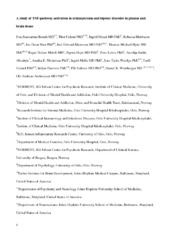| dc.contributor.author | Hoseth, Eva Zsuzsanna | en_US |
| dc.contributor.author | Ueland, Thor | en_US |
| dc.contributor.author | Dieset, Ingrid | en_US |
| dc.contributor.author | Birnbaum, Rebecca | en_US |
| dc.contributor.author | Shin, Joo Heon | en_US |
| dc.contributor.author | Kleinman, Joel Edward | en_US |
| dc.contributor.author | Hyde, Thomas Michael | en_US |
| dc.contributor.author | Mørch, Ragni Helene | en_US |
| dc.contributor.author | Hope, Sigrun | en_US |
| dc.contributor.author | Lekva, Tove | en_US |
| dc.contributor.author | Abraityte, Judita Aurelija | en_US |
| dc.contributor.author | Michelsen, Annika | en_US |
| dc.contributor.author | Melle, Ingrid | en_US |
| dc.contributor.author | Westlye, Lars Tjelta | en_US |
| dc.contributor.author | Ueland, Torill | en_US |
| dc.contributor.author | Djurovic, Srdjan | en_US |
| dc.contributor.author | Aukrust, Pål | en_US |
| dc.contributor.author | Weinberger, Daniel R. | en_US |
| dc.contributor.author | Andreassen, Ole Andreas | en_US |
| dc.date.accessioned | 2019-04-16T12:09:59Z | |
| dc.date.available | 2019-04-16T12:09:59Z | |
| dc.date.issued | 2017-07 | |
| dc.Published | Hoseth Ez, Ueland T, Dieset I, Birnbaum, Shin, Kleinman, Hyde, Mørch RH, Hope SH, Lekva T, Abraityte JA, Michelsen A, Melle I, Westlye LT, Ueland T, Djurovic S, Aukrust P, Weinberger DR, Andreassen OA. A study of TNF pathway activation in schizophrenia and bipolar disorder in plasma and brain tissue. Schizophrenia Bulletin. 2017;43(4):881-890 | eng |
| dc.identifier.issn | 0586-7614 | |
| dc.identifier.issn | 1745-1701 | |
| dc.identifier.uri | https://hdl.handle.net/1956/19362 | |
| dc.description.abstract | Objective: A proinflammatory imbalance in the tumor necrosis factor (TNF) system may contribute to the pathogenesis of schizophrenia (SCZ) and bipolar disorders (BDs) and related comorbidities. We investigated the relative distribution of TNF-related molecules in blood and dorsolateral prefrontal cortex (DLPFC) in these disorders. Method: We measured plasma levels of TNF, soluble TNF receptor 1 (sTNFR1), soluble TNF receptor 2 (sTNFR2), and a disintegrin and metalloprotease-17 (ADAM17) using enzyme immunoassays and calculated the TNF/sTNFRs ratio (TNF/sTNFR1+sTNFR2) in a sample of 816 SCZ and BD spectrum patients and 624 healthy controls (HCs). TNF, TNFRSF1A (TNFR1), TNFRSF1B (TNFR2), and ADAM17 mRNA levels were determined in whole blood, and postmortem DLPFC obtained from an independent cohort (n = 80 SCZ, n = 44 BD, and n = 86 HC). Results: In peripheral blood, we show increased TNF-related measures in patients compared to HC, with an increased TNF/sTNFRs ratio (p = 6.00 × 10−5), but decreased TNF mRNA expression (p = 1 × 10−4), with no differences between SCZ and BD. Whole blood ADAM17 mRNA expression was markedly higher in BD vs SCZ patients (p = 1.40 × 10−14) and vs HC (p = 1.22 × 10−8). In postmortem DLPFC, we found no significant differences in mRNA expression of TNF pathway genes between any groups. Conclusions: SCZ and BD patients have increased plasma TNF pathway markers without corresponding increase in blood cell gene expression. ADAM17 expression in leukocytes is markedly different between the two disorders, while alterations in TNF-related gene expression in DLPFC are uncertain. Further studies are necessary to elucidate the aberrant regulation of the TNF pathway in severe mental disorders. | en_US |
| dc.language.iso | eng | eng |
| dc.publisher | Oxford University Press | eng |
| dc.subject | DLPFC | eng |
| dc.subject | Cytokines | eng |
| dc.subject | working memory | eng |
| dc.subject | mRNA | eng |
| dc.subject | postmortem | eng |
| dc.title | A study of TNF pathway activation in schizophrenia and bipolar disorder in plasma and brain tissue | en_US |
| dc.type | Peer reviewed | |
| dc.type | Journal article | |
| dc.date.updated | 2018-11-13T11:26:05Z | |
| dc.description.version | acceptedVersion | en_US |
| dc.rights.holder | Copyright The Author 2017. Published by Oxford University Press on behalf of the Maryland Psychiatric Research Center. All rights reserved. | |
| dc.identifier.doi | https://doi.org/10.1093/schbul/sbw183 | |
| dc.identifier.cristin | 1499086 | |
| dc.source.journal | Schizophrenia Bulletin | |
